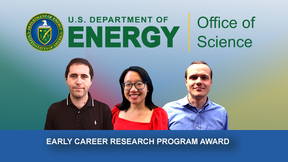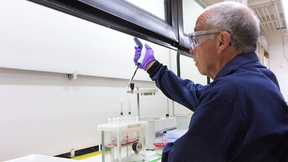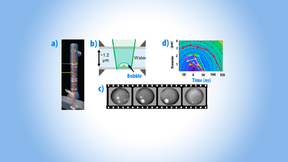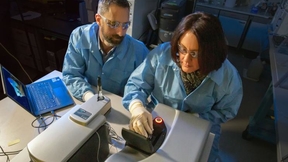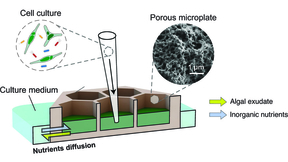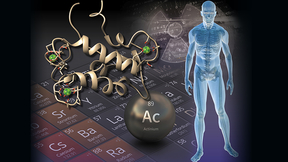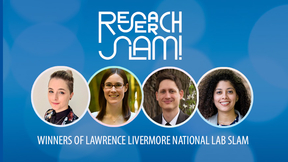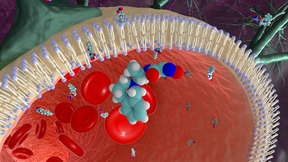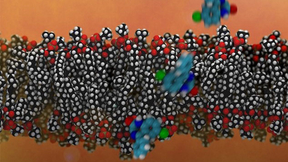Back
The Laboratory’s cutting-edge capabilities and expertise offer new tools to study ALS disease mechanisms and fuel hope for a cure.
Gareth Trubl and researchers from Sandia National Laboratories have created a new computer tool called Tiger2 that scans DNA and looks for genomic islands—sections that look different than the surrounding DNA. Genomic islands are important for understanding life, infection, evolution, and more. These sections typically house antibiotic resistant and toxin producing genes…
A Lawrence Livermore National Laboratory (LLNL) team will be among the first researchers to perform work on the world’s first exascale supercomputer — Oak Ridge National Laboratory’s Frontier — when they use the system to model cancer-causing protein mutations. Led by Harsh Bhatia, a computer scientist in the Center for Applied Scientific Computing (CASC) at LLNL, the team…
Three scientists from Lawrence Livermore National Laboratory (LLNL) are recipients of the Department of Energy’s (DOE) Office of Science Early Career Research Program award. Mimi Yung, John Despotopulos and Timofey Frolov are among 83 awardees receiving the recognition. Under the program, typical awards for DOE national laboratory staff are $500,000 per year for five years…
Even after taking highly stressful exams in college, grades can still be important. Just ask researchers at Lawrence Livermore National Laboratory’s (LLNL) Forensic Science Center (FSC). Every fall, chemists and other researchers from the FSC spend two weeks of long days undertaking the Organisation for the Prohibition of Chemical Weapons (OPCW) environmental proficiency…
Lawrence Livermore National Laboratory (LLNL) scientists exploring the interaction between cancer cells and the extracellular matrix (ECM) — the “scaffolding” of organs — found that proteins in the ECM can dramatically impact the immune system’s ability to kill tumors. Researchers said the findings, published online in the journal Biomaterials, could represent a novel…
Whether dead or alive, soil microorganisms play a major role in the biogeochemical cycling of carbon in the terrestrial biosphere. But what is the specific role of death for the bacteria, fungi and microfauna that make up the soil microbiome? That is the topic of a new review by Lawrence Livermore National Laboratory (LLNL) scientists and collaborators. The article,…
An international team of scientists has found new biomarkers that can be used for diagnostic purposes and potentially as predictive tools of the risks associated with deep-space flight. In their study, the team, including three researchers from Lawrence Livermore National Laboratory (LLNL), examined approximately two-decade-old blood samples from space shuttle astronauts…
The Department of Energy’s (DOE’s) Early Career Research Program (ECRP) aims to bolster the nation’s scientific workforce by providing support to exceptional researchers at U.S. academic institutions and DOE’s national laboratories during their early career years. Annually, ECRP provides research funding to full-time staff in their first 10 years post-doctorate.
The formation and collapse of microscopic bubbles is important in a wide range of fields as both a potential mechanism behind tissue damage, such as in cases of blast-wave-induced traumatic brain injury, and as a useful tool for technology applications, such as mechanical properties evaluation, nanomaterials manipulation and surface cleaning. Nanobubbles have been of…
Antibiotics have allowed for the widespread control of bacterial infections, which had been the leading cause of death historically. However, the overuse of traditional antibiotics in humans and animals resulted in the emergence of stronger, more potent bacterial strains that are no longer treatable with conventional antibiotics. Researchers at Lawrence Livermore National…
Scientists from Lawrence Livermore National Laboratory (LLNL) and three other institutions are seeking to develop a multi-pathogen vaccine that will protect against three bacterial biothreat pathogens. Led by LLNL, the team includes disease experts from the University of New Mexico Health Sciences Center (UNMHSC), the University of Nevada, Reno School of Medicine (UNR Med)…
Lawrence Livermore National Laboratory (LLNL) researchers and a multi-institutional team of scientists have developed a highly detailed, machine learning-backed multiscale model revealing the importance of lipids to the signaling dynamics of RAS, a family of proteins whose mutations are linked to numerous cancers. Published by the Proceedings of the National Academy of…
Microscopic algae are responsible for half of the global atmospheric carbon fixed from the atmosphere through photosynthesis, and may be used as a sustainable bioenergy source. The water immediately outside their cells, called the “phycosphere,” is rich with algal-excreted organic carbon, and is an ideal ecosystem for bacterial growth. However, detecting and measuring…
Lawrence Livermore National Laboratory’s (LLNL’s) fifth annual Research Slam! took place virtually on October 6th and featured 14 LLNL postdocs, 9 of which represented the Physical and Life Sciences Directorate (PLS). Over 300 people logged on to attend the live two-hour event, enthusiastically cheering for their favorite postdocs in the comment section. Each finalist was…
Lawrence Livermore National Laboratory (LLNL) and Penn State scientists have demonstrated how a protein can be recovered and purified for radioactive metals like actinium that could be beneficial for both next-generation drugs used in cancer therapies and the detection of nuclear activities. Radioactive metals hold unique and essential places in a variety of medical…
The top winners of the recent Lawrence Livermore National Laboratory (LLNL) Research Slam!, a speaking competition for postdocs, will advance to the Bay Area Research SLAM set for Thursday, Oct. 28. The Bay Area Research SLAM! is a collaboration between the Bay Area’s national labs (Lawrence Berkeley National Laboratory, LLNL, Sandia National Laboratories and SLAC National…
Scientists at Lawrence Livermore National Laboratory (LLNL) have developed a new, versatile antidote to counteract exposure to nerve agent poisoning. The work, appearing in the journal Scientific Reports, was the result of a highly iterative process built in collaboration between LLNL’s Global Security Directorate, its Forensic Science Center and the U.S. Army Medical…
A team led by LLNL scientists has discovered the first antidote against nerve-agent poisoning that crosses the blood–brain barrier (BBB). Their research, published in Scientific Reports, comes on the heels of a recent resurgence of nerve agents in transnational conflicts. Organophosphorus-based nerve agents (OPNAs)—including sarin, soman, and VX—cross the BBB and are…
Recent advances in body armor and other battlefield damage control strategies have increased the proportion of survivable blast-related combat injuries. Over the last few decades, treatment of warfighters surviving increasingly severe injuries has created new challenges across the Department of Defense’s Military Health System.




